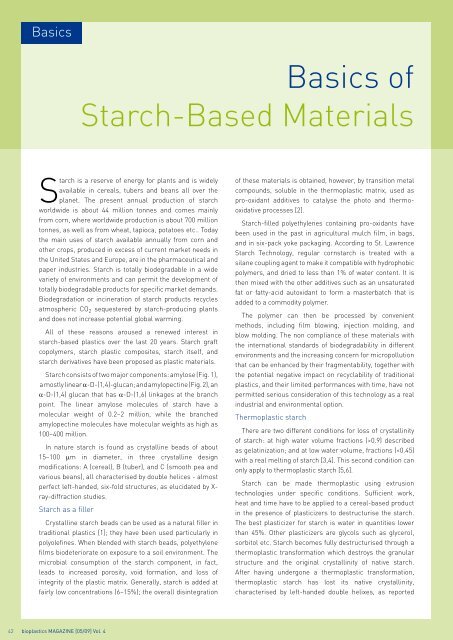bioplasticsMAGAZINE_0905
bioplasticsMAGAZINE_0905
bioplasticsMAGAZINE_0905
Create successful ePaper yourself
Turn your PDF publications into a flip-book with our unique Google optimized e-Paper software.
Basics<br />
Basics of<br />
Starch-Based Materials<br />
Starch is a reserve of energy for plants and is widely<br />
available in cereals, tubers and beans all over the<br />
planet. The present annual production of starch<br />
worldwide is about 44 million tonnes and comes mainly<br />
from corn, where worldwide production is about 700 million<br />
tonnes, as well as from wheat, tapioca, potatoes etc.. Today<br />
the main uses of starch available annually from corn and<br />
other crops, produced in excess of current market needs in<br />
the United States and Europe, are in the pharmaceutical and<br />
paper industries. Starch is totally biodegradable in a wide<br />
variety of environments and can permit the development of<br />
totally biodegradable products for specific market demands.<br />
Biodegradation or incineration of starch products recycles<br />
atmospheric CO 2 sequestered by starch-producing plants<br />
and does not increase potential global warming.<br />
All of these reasons aroused a renewed interest in<br />
starch-based plastics over the last 20 years. Starch graft<br />
copolymers, starch plastic composites, starch itself, and<br />
starch derivatives have been proposed as plastic materials.<br />
Starch consists of two major components: amylose (Fig. 1),<br />
a mostly linear a-D-(1,4)-glucan; and amylopectine (Fig. 2), an<br />
a-D-(1,4) glucan that has a-D-(1,6) linkages at the branch<br />
point. The linear amylose molecules of starch have a<br />
molecular weight of 0.2–2 million, while the branched<br />
amylopectine molecules have molecular weights as high as<br />
100–400 million.<br />
In nature starch is found as crystalline beads of about<br />
15–100 mm in diameter, in three crystalline design<br />
modifications: A (cereal), B (tuber), and C (smooth pea and<br />
various beans), all characterised by double helices - almost<br />
perfect left-handed, six-fold structures, as elucidated by X-<br />
ray-diffraction studies.<br />
Starch as a filler<br />
Crystalline starch beads can be used as a natural filler in<br />
traditional plastics [1]; they have been used particularly in<br />
polyolefines. When blended with starch beads, polyethylene<br />
films biodeteriorate on exposure to a soil environment. The<br />
microbial consumption of the starch component, in fact,<br />
leads to increased porosity, void formation, and loss of<br />
integrity of the plastic matrix. Generally, starch is added at<br />
fairly low concentrations (6–15%); the overall disintegration<br />
of these materials is obtained, however, by transition metal<br />
compounds, soluble in the thermoplastic matrix, used as<br />
pro-oxidant additives to catalyse the photo and thermooxidative<br />
processes [2].<br />
Starch-filled polyethylenes containing pro-oxidants have<br />
been used in the past in agricultural mulch film, in bags,<br />
and in six-pack yoke packaging. According to St. Lawrence<br />
Starch Technology, regular cornstarch is treated with a<br />
silane coupling agent to make it compatible with hydrophobic<br />
polymers, and dried to less than 1% of water content. It is<br />
then mixed with the other additives such as an unsaturated<br />
fat or fatty-acid autoxidant to form a masterbatch that is<br />
added to a commodity polymer.<br />
The polymer can then be processed by convenient<br />
methods, including film blowing, injection molding, and<br />
blow molding. The non compliance of these materials with<br />
the international standards of biodegradability in different<br />
environments and the increasing concern for micropollution<br />
that can be enhanced by their fragmentability, together with<br />
the potential negative impact on recyclability of traditional<br />
plastics, and their limited performances with time, have not<br />
permitted serious consideration of this technology as a real<br />
industrial and environmental option.<br />
Thermoplastic starch<br />
There are two different conditions for loss of crystallinity<br />
of starch: at high water volume fractions (>0.9) described<br />
as gelatinization; and at low water volume, fractions (


















